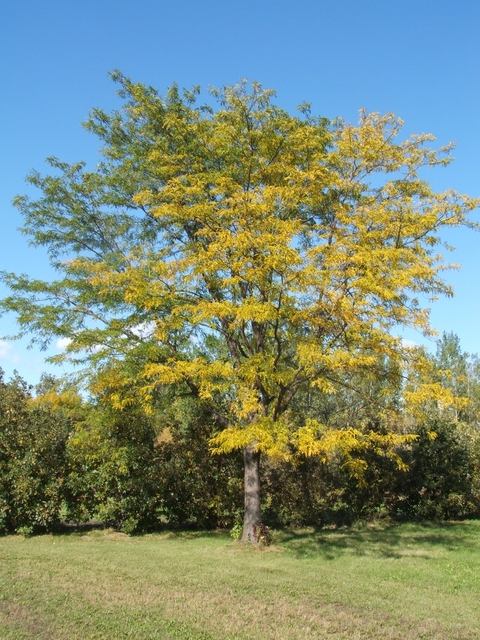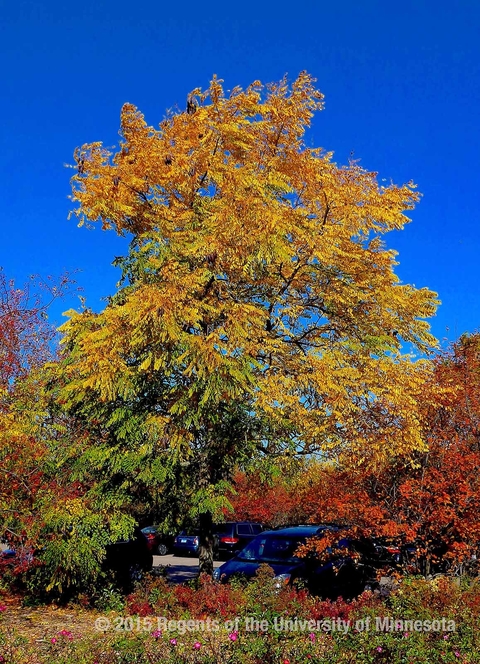Trees contribute a great deal to any landscape: shade, structure, a canopy “ceiling”, protection and wildlife habitat. The following list of recommendations does not cover all the trees available for Minnesota landscapes, but these trees serve as good options for yards, gardens, and communities.
The UMN Forest Resources trees, shrubs and vines database lists and describes different types of trees, shrubs and vines.
Deciduous trees
Accent trees
Heritage river birch (Betula nigra ‘Cully’)
- Exfoliating bark that ranges from tan to almost white.
- Resistant to bronze birch borer.
- Tolerant of wet, poorly drained soils.
- Requires soil pH 7.2 or less.
- Height: 45-50 ft. Spread: 30-35 ft. Full sun. Zones 4-8.
Dakota Pinnacle® Asian white birch (Betula platyphylla ‘Fargo’)
Developed by NDSU, this is a medium to small graceful white birch.
- Striking narrowly pyramidal form.
- It will succumb to bronze birch borer, so keep it well-watered, plant in a garden bed to avoid compacted soil, and mulch the root zone. It’s worth the extra work.
- Height: 35 ft. Spread: 12 ft. Full sun. Hardy in Zones 3a - 7.
Shagbark hickory (Carya ovata)
- Highly recommended for zone 4 and especially southeastern Minnesota.
- A Minnesota native, this plant features large, flat curving plates of peeling bark (hence its common name) and produces edible nuts (excellent wildlife value).
- Hard to get large sized trees in nurseries. Check with a local native plant nursery.
- Height: 80 ft. Spread: 50 ft. Full sun. Zones 4-9.
Flowering trees
Serviceberry, Juneberry, Saskatoon berry, Shadblow (Amelanchier speciosa)
- Not planted enough, this small tree features white spring flowers, purple to black edible fruit (rivals blueberry), red fall foliage and soft gray bark.
- Height: 25 ft. Spread: 25 ft.
- Developed for fruit production, the shrub form 'Regent' (Amelanchier alnifolia ‘Regent’) is an excellent addition to a home landscape.
- Height: 6 ft. Spread: 6 ft.
- Tolerant of various soils.
- Full sun to partial shade. Zones 2-7.
Northern catalpa (Catalpa speciosa)
Best performing urban tree from Arbor Day planting records dating back to 1995.
- Large form with heart-shaped leaves and bunches of fragrant, white orchid-like flowers that form long green pods.
- Tolerant of a wide variety of soil types.
- Height: 60 ft. Spread: 40 ft. Full sun. Hardy in zones 4-6.
Shade trees
First Editions® Matador™ maple (Acer x freemanii ‘Bailston’)
- Hybrid of silver and red maples. Adaptable.
- Symmetrical upright form, deep red fall color that comes later and stays longer.
- A better-built cousin to Autumn Blaze® maple.
- Height: 40-45 ft. Spread: 20-40 ft. Full sun. Zones 4-7.
Silver Queen silver maple (Acer saccharinum ‘Silver Queen’)
- Like all maples, shallow roots are still an issue.
- A cultivar of our native, this silver maple is very well built, site tolerant and about ⅔ the size of the species at maturity.
- Great shade tree if given plenty of room. Do not plant it on a boulevard.
- Height: 50 ft. Spread: 40 ft. Full sun. Zones 3-7.
Hackberry (Celtis occidentalis)
- This deciduous tree does well in just about any type of soil as long as it is not a swamp.
- Foliage turns gold in fall and birds love the black berries.
- Corky, knobby bark is interesting year-round. A good urban tree and wildlife plant.
- Height: 60 ft. Spread: 60 ft. Full sun. Reliably hardy in zones 2-9
Northern Acclaim® thornless honeylocust (Gleditsia triacanthos var. inermis ‘Harve’)
An NDSU introduction, this seedless variety from the legume family is a tough urban tree featuring bright green foliage that changes to gold in the fall.
- Pyramidal form. Provides filtered shade. One of the best shade trees to grow if you also value a healthy lawn beneath it.
- Height: 50 ft. Spread: 35 ft. Full sun. Zones 3b-6.
True North™ Kentucky Coffeetree (Gymnocladus dioica ‘UMNSynergy’):
A University of Minnesota introduction that provides yellow fall color.
- A male selection, so no messy pods.
- A member of the Fabaceae (legume) botanical family.
- Disease resistant and tolerant of heat, cold, wind and dry soils with high pH.
- Good tolerance to both deicing salt spray and run off.
- Height: 50-70 ft. Spread: 25-35 ft. Full sun. Hardy to zones 4-9.
Summertime amur maackia (Maackia amurensis ‘Summertime’)
A University of Minnesota introduction and one of our best performing, brownfield site trees.
- Typical of the members of the legume family, it is tough as nails, can live in very poor (but well-drained) soil and still look good.
- Height: 15-20 ft. Spread: 12-15 ft. Full sun. Zones 3-8.
Cottonwood (Populus deltoides)
- Cottonwoods are very large, dramatic trees with shiny, delta-shaped leaves and deeply ridged bark.
- Female trees produce sticky seed buds and masses of downy white “cotton” that clings to window screens, gathers in gutters and seems to be everywhere.
- The male Cottonwood is an under-used, large quality tree that does not have the cottony seed. It is found everywhere in Minnesota and a favorite for nesting eagles.
- Height: 100 ft. Spread: 75 ft. Full sun. Hardy in zones 3-9.
- Buy from a reputable nursery source.
Majestic Skies™ Northern pin oak (Quercus elipsoidalis ‘Bailskies’)
- Red spring foliage changes to dark green in summer and a deep red in fall.
- Symmetrical form makes this plant stand out in any landscape.
- A very well-built tree that requires minimal developmental pruning.
- Height: 60 ft. Spread: 45 ft. Full sun. Zones 3-8.
Dutch elm disease-resistant elms
- Asiatic cultivars:
- Accolade® (Ulmus 'Morton') Height: 50 ft. Spread: 40 ft.
- Triumph™ (Ulmus ‘Morton Glossy’) Height: 60 ft. Spread: 40 ft.
- Both have very good form and growth rate, are easy to maintain and have the best disease resistance of DED-resistant elms.
- Other species and varieties suitable for Zone 3 (and 4) with pretty good resistance:
- 'Prairie Expedition’ (Ulmus americana ‘Lewis and Clark') Height: 60 ft. Spread: 40 ft. Full sun.
- 'Discovery' (Ulmus davidiana var. japonica ‘Discovery’) Height: 30 ft. Spread: 40 ft. Full sun.
To help minimize Dutch elm disease:
- Elm varieties should never represent more than 5% of the total tree population.
- Elm trees should never be planted closer than 60 feet from each other.
Conifers
Concolor fir, white fir (Abies concolor)
Minnesotans fell in love with the Colorado blue spruce, then it came down with needlecast disease.
- The Concolor fir is a great substitute for blue spruce, without having to worry about managing a stubborn fungal disease.
- Soft, fragrant and blue-ish foliage. Pinkish-tan upright cones.
- Height: 50 ft. Spread: 20 ft. Full sun. Zones 3-7.
American larch or tamarack (Larix laricina)
- A deciduous conifer, larch have clusters of short bright green needles that turn golden and drop off in autumn.
- Grown in full sun, this under-utilized tree performs well in wet to normal (mesic) soils.
- Tolerant of deicing salt spray.
- Height: 60 ft. Spread: 30 ft. Full sun. Hardy in zones 2-5.
White pine (Pinus strobus)
The white pine is a fixture in northern boreal forests.
- Fine feathery needles, irregular dramatic form especially when mature, and large sticky cones.
- The white pine attracts many kinds of wildlife and should be planted with plenty of space to stretch out its branches.
- Prefers acidic soil that is moist and well-drained, but moderately tolerant of soils with a slightly higher pH.
- If white pine blister rust is a problem in your landscape area, choose the disease-resistant variety ‘Patton’s Silver Splendor’ (Pinus strobus ‘Patton’s Silver Splendor’).
- Height: 80 ft. Spread: 40 ft. Full sun to light shade. Zones 3-7.
Reviewed in 2023



















